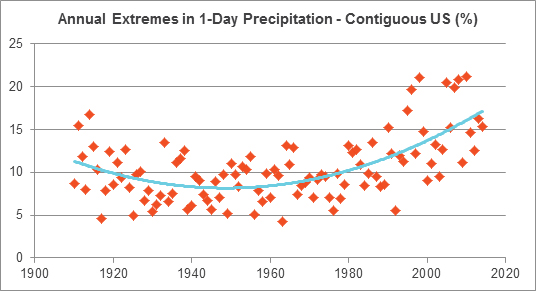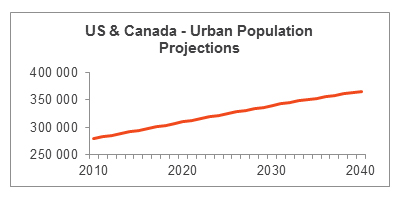Reliability – A Business-Critical Requirement For Water And Wastewater Utilities
Global Changes – Local Impacts
Water and wastewater utilities and their operators are facing an unprecedented challenge in managing their physical assets. There is a perfect storm brewing that is putting significant pressure on these assets and it is imperative that they function to (or exceed) design capabilities. These assets truly are the lifeblood for delivering on the expected levels of service to the utility’s customers.
Some of the challenges that make up this “perfect storm” include:
- An increase in unpredictable weather events.

Figure 1 - Source: National Oceanic and Atomospheric Association
- Ever tightening capital budgets causing a significant infrastructure funding gap.
“In 2002, the U.S. EPA released the Clean Water and Drinking Water Gap Analysis. This report estimated that if investment in water and wastewater infrastructure does not increase to address anticipated needs, the funding gap over the next 20 years could grow to $122 billion for clean water capital costs and $102 billion for drinking water capital costs. There is also a funding gap for operation and maintenance, which was found to be $148 billion for clean water and $161 billion for drinking water. This points to a total gap of over $500 billion dollars.” – http://water.epa.gov/infrastructure
- Growing populations, particularly in urban centers

Figure 2 - Source: United Nations - Population Division Website
- Tightening water quality and environmental regulations as seen in the amended Safe Drinking Water Acts in the US and Canada, which regularly introduce new regulation and prohibited contaminants.
Unfortunately, in the face of these challenges, there are few tools available to help a water/wastewater utility or operator to survive and, ideally, thrive. One such tool is a business-focused, technically-based maintenance and reliability program.
Why Does Reliability Matter?
Put simply, from a cost benefit perspective, business-focused, technically-based maintenance and reliability programs are arguably the most economically feasible and successful method for thriving in this complex environment. As a utility’s asset base begins to degrade and long range capital budgets are slashed, applying reliability principles aimed at getting the most out of the existing asset base, extending asset life and simultaneously ensuring that new capital assets are properly managed is more than a nice-to-have, it is imperative.
At its root, a well-designed maintenance and reliability program will:
- Identify and quantify high risk assets to allow for prioritization of maintenance, operations and new capital efforts.
- Identify and mitigate known causes of failure to ensure equipment functions to its intended design requirements.
- Reduce susceptibility to extreme events.
- Optimize maintenance and operating costs.
- Ensure spare parts are on hand when they are needs… And aren’t when they’re not.
- Defer capital and extend asset life based on current asset condition, asset life cycle evaluations, and objective risk assessment.
- Ensure new assets are adequately cared for and available to operate for their entire expected life.
- Ensure the organization builds a culture of asset care and continuous improvement into the workforce.
So Why Do Reliability Programs Fail (And How To Prevent It)?
Despite the strong business case and clear benefits of implementing a business-focused, technically based maintenance and reliability program, it is unfortunately also the case that such programs often fail to deliver on their promise. There are a number of typical reasons for this, some of which are outlined below:
- Lack of leadership support – In an informal interview process I conducted with a number of clients, this was cited as the most common cause for failure. In essence, this can usually be attributed to:
- Lack of a well-defined business case to identify the benefits of implementing the program.
- Poor communication of the scale and impact of implementing a reliability program on the rest of the organization.
- View of maintenance and reliability as a cost center amongst senior leadership.
What to do - Often these programs are owned and managed by mid-level and even senior managers that are very knowledgeable and have great intentions but lack the clout to champion the program. Reliability now belongs in the COO’s portfolio. It is a vital tool at their disposal that allows them to meet their service level agreements with existing assets and allows them to request capital based on validated risk exposure. It is imperative to engage those leaders early and build a business case that clearly outlines the benefits to your organization. You should also ensure the business case is presented in the language of your senior management and is aligned to their vision. Don’t shy away from critical issues of cost and risk.
- Project vs. program – Many organizations will begin a reliability improvement initiative and will treat it as a project, rather than as a program. This inevitably leads to a lack of sustainment of the effort and poor implementation of the outcomes of the development work.
What to do – Build a sustainment plan from the outset. Ensure the KPI’s that are selected to monitor the program are both project based (schedule, budget, etc.) as well as performance based (availability, cost per unit treated, etc.). Also, make sure there is a clear mandate for change management and sustainment support and appropriate budget allocated to that effort. Finally, ensure that program performance and the value delivered through the program is quantified and communicated with the senior leadership team, as well as front line staff.
- Reliability as “extra work” – This failure cause reflects the tendency for many organizations to view reliability as work that is above and beyond their “real work” and assign people to support the program that are convenient, as opposed to using their best people. This is often seen when people on “light duty” are the ones used to support a program at its launch.
What to do – Get the key technical and leadership people “into the tent” from the beginning of the project. Too often reliability is isolated in a department like engineering or maintenance. It is vital to engage individuals from the various groups of stakeholders in the organization, including Operations, Maintenance, Supply Chain and Engineering, from the beginning of the program.
- It’s all about the software – In many cases, people become transfixed by the software tools and the tool quickly becomes the focal point for the initiative. While software tools are important, it is my experience that process, practice and people are the most important elements that will drive success.
What to do – Build and implement business processes and drive tool selection based on the process that will work for your organization. Effectively put the horse before the cart.
- Boiling the ocean – Too often, people will begin a reliability program implementation with the best of intent but quickly become overwhelmed with the size and scale of the activity. This can often be seen when there is a short-term, high level of investment but support for the project quickly evaporates when meaningful improvements to equipment performance and cost measures aren’t seen in the first few months of the program.
What to do – It is critical that early efforts show tangible and meaningful wins that can be (and are) communicated throughout the organization. Therefore, you should focus on low effort, high return battles and build your program from there.
- Lack of attention to change and integration – Many organizations will devote significant technical resources to a reliability initiative, but with little regard to the impact of the program on the “day to day” lives of the people who work there. This causes fear and distrust of the program and often a passive aggressive approach that will inevitably cause the program to fail.
What to do – Put dedicated resources and budget to tackle the change and cultural development aspects of the program. Ensure that these resources aren’t just about holding hands and singing Kumbaya but have a well-defined and structured approach to leading the change elements. Change leadership needs to be focussed on delivering the result and not a broad brush function. Often organizations hire a change person and leave them in the corner without truly engaging the organization or partnering with the project leadership.
